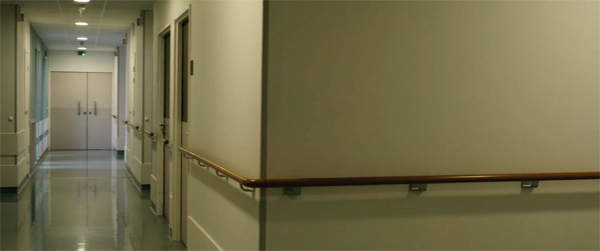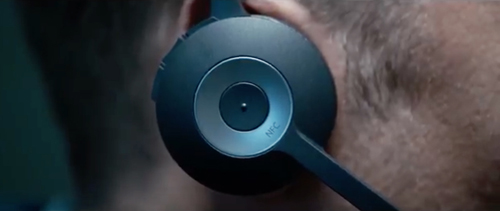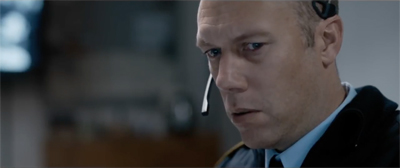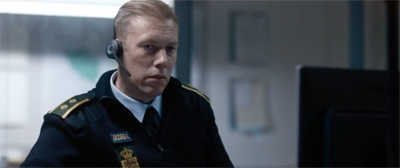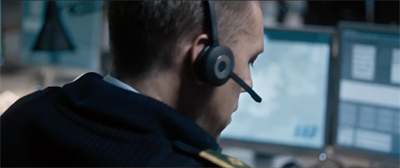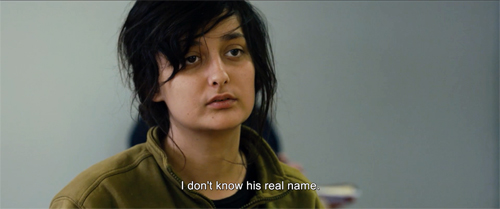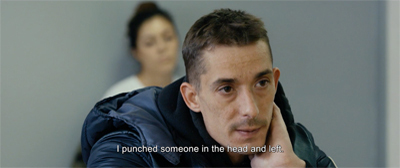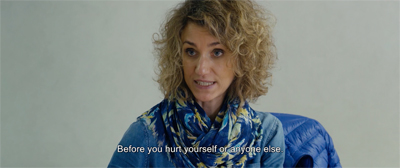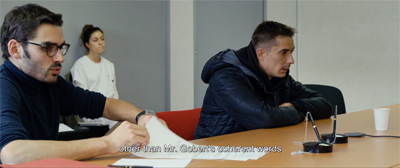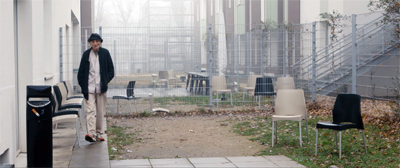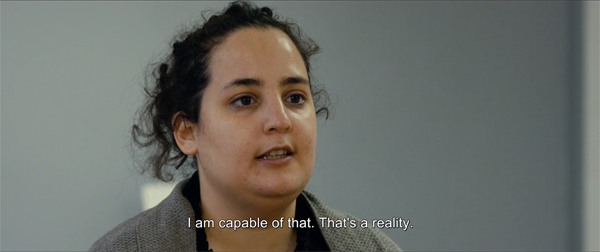Wisconsin Film Festival: Confined to quarters
Thursday | April 19, 2018 open printable version
open printable version
12 Days (2017).
DB here:
I try to watch any film at two levels. First, I want to engage with it, opening myself up to the experience it offers. Second, I try to think about how the film is made, why it’s made this way, and what those practices and principles can teach me about the possibilities of the medium. That second level of response, not easy to sustain in the thick of projection, comes from my research interests, something spelled out as the “poetics of cinema.”
Most critics, particularly those reviewing films on a daily basis, don’t have the time or inclination to reflect on that second level. I’m lucky to have the leisure to mull over what this or that film can suggest about film in general. When a new release points me toward something I think is intriguing, I’ll go back and watch it again. I saw Zama three times last year, and Dunkirk five times. After three viewings and getting the Blu-ray, I think I’m ready to write about Phantom Thread fairly soon.
Several films at the festival set me thinking. Vanishing Point (1971), which I hadn’t seen in a long time, confirmed my idea in Reinventing Hollywood that 1940s narrative strategies resurfaced in the 1970s. (Whew.) We get a crisis structure motivating a flashback, which itself embeds further flashbacks, everything tricked out with plenty of road rage.
Philippe Garrel’s Lover for a Day (L’Amant d’un jour, 2017) reminded me of how important coincidence is in narrative, particularly the accidental discovery of an important item of narrative information. You know, like coming home just as somebody’s about to commit suicide. Or discovering on your way to the WC that your lover’s having sex with someone else. I began to wonder if the episodic nature of art films, which are built more on routines than on sharply articulated goals, gets away with such handy accidents by suggesting that with so many characters drifting around, they’re bound to intersect occasionally. Realism once more becomes an alibi for artifice.
And I was happy to see American Animals (2018), an amateur-heist movie that uses my friend the flashback in a way that cunningly misleads us. I will say no more, except to refer you to other reflections on caper movies, and to express my hope that Ocean’s 8 will offer some fresh twists too.
All of these films employ what we might call omniscient point of view. The film’s narration shifts us among many characters in many places and times. Herewith, though, some thoughts on two films that tie us down.
Elbow room
The Guilty (2018).
One of cinema’s great powers is its ability to shift locales in the blink of an eye. Unlike proscenium theatre, bound to drawing rooms or perspective streets, a film can carry us from place to place instantly. Novels can do this too, of course, and so can certain theatre traditions, such as Shakespeare’s wooden O. But cinematic crosscutting swiftly from one line of action to another and back again is such a powerful tool that many theorists identified it as part of the inherent language of cinema. The medium seemed wired for camera ubiquity.
At certain periods, though, filmmakers kept to single spaces. Early cinema’s one-shot films locked us to a single view, and in the 1910s, long scenes would play out in salons and parlors. Even after the arrival of crosscutting and other editing strategies, some filmmakers embraced the kammerspiel, or “chamber play” aesthetic popularized in Germany. Lupu Pick’s Sylvester (1924), Dreyer’s Master of the House (1925), and other silent films built drama out of micro-actions in tight spaces. Later Hitchcock took this premise to an extreme in Lifeboat (1944), Rope (1948), Rear Window (1954), and to some extent in Dial M for Murder (1954). Rossellini’s Human Voice (1948) is another instance which, like Rope and Dial M, was based on a play.
The confined-space option reemerges every few years. Put aside Warhol’s psychodramas, so well analyzed by J. J. Murphy in his book The Black Hole of the Camera. Most of Tape (2001), Panic Room (2002), Phone Booth (2002), Locke (2013), and Room (2015) follow this formal option. Two striking films from our festival show that this strategy still holds a fascination for directors. They know that spatial concentration can shape the audience’s experience in unique ways.
In The Guilty director Director Gustav Möller ties us to Asger, a Danish policeman assigned to answering calls on an emergency line. A woman caller tells him she’s been kidnapped, and he tries to locate her while also giving her advice on how to protect herself. In the meantime, he summons police units to track the car she’s in and to investigate the household she’s left behind. In the course of this, we come to understand that he’s grappling with his own problems. He’s about to go before a judge for an action he committed on duty, and his partner is going to testify about it. The whole action takes place in more or less real duration, in eighty-some minutes of one night.
The Slender Thread (1965) similarly includes longish stretches confined to a suicide-hotline agency, but it supplies flashbacks that take us into the caller’s past. Here, we stay in place with Asger. By confining us to what he hears, and what little he sees on his GPS screen, the narration obliges us to make inferences that seem reasonable but that turn out to be invalid. I can’t say more without giving away the twists, but it’s worth mentioning how keeping major action offscreen enables the film to summon up the Big Three: curiosity (about the past), suspense (about the future), and surprise (about our mistaken assumptions).
The Guilty is a sturdy thriller, and it certainly works on its own terms. While restricting us to a character, it doesn’t plunge–as many films would have been tempted to do–into his mind, by means of flashbacks or fantasies. These would have “opened out” the film, but lost the laconic objectivity of the action we get.
The film coaxed me to reflect on how the reliance on the conversational situation allowed for a certain looseness at the level of pictorial style. Once we’re tethered to Asger at his workstation, not a lot hangs on choices about camera placement or shot scale. As long as his face, gestures, and body behavior are apparent, niceties of framing count for less. His reaction can be signaled adequately from many angles. He’s so stone-faced that even a 3/4 view from the rear suffices.
In other words, I can’t see that the situation is submitted to a stylistic pattern that would add another dose of rigor to the filmic texture. The style, I think, works to adjust our attention in the moment, in the manner of what I’ve called “intensified continuity,” rather than building longer arcs of pictorial interest. While the plot constraints are strict, the visual style seems less so.
What would be a way to make pictorial style more active? Well, the obvious cases are Hitchcock’s long takes in Rope and optical point-of-view in Rear Window. (And, I’d suggest, his use of 3D in Dial M.) Dreyer did something similar in The Master of the House, in which editing patterns activate a range of props and bits of setting. Films like these benefit from including several characters onscreen, providing details of setting and building up spatial “rules” that channel our vision. Or think of Kiarostami’s auto trips (I almost said “car-merspiel”), which limit camera setups pretty stringently. Ditto Panahi’s ways of stretching the notion of “house arrest” in This Is Not a Film (2011), Closed Curtain (2013), and Taxi (2015)–films that tantalize us with the possibility of glimpsing the world outside.
Möller chose, with good reason, to rivet our attention on two basic elements: the calls and Asger’s responses. The cop’s interactions with others in the office are minimal, and there’s almost no play with props or setting, apart from a moment when Asger decisively snaps down the windowblinds. Our attachment breaks off only at the end, at the conventional moment when the protagonist turns from the camera and walks away.
The tight concentration enhances both plot action and character revelation, and we’re obliged to listen more closely than we do in most movies. Along the way, blinks and eye-shifts and finger-tapping become major events. Still, The Guilty reminded me that every choice cuts off others, forces new choices, sets up constraints–and new opportunities. Film art is full of trade-offs.
12 Day wonder
12 Days (2017).
A more “dialectical” approach to confined space is on display in Raymond Depardon’s documentary 12 Days (2017), probably the most emotionally wrenching film I saw at our fest. The situation is a similar to that in his Délits flagrants (1994), which recorded police interrogations of suspects. The official procedure captured here is a hearing, mandated within twelve days of a patient’s being involuntarily committed to a psychiatric hospital. A judge reviews the case to determine whether the patient should be set free.
Sessions with ten patients take us along a spectrum of disturbance, from a woman believing herself persecuted in her office to a man whose inner voices commanded him to stab a stranger. The last petitioner, a woman sufficiently aware of her illness to admit that she can’t care for her baby, makes a lucid case for being allowed to visit the child occasionally.
All these encounters are shot in a simple but strict fashion. In three reverse-shot setups, we see the petitioner, the judge, and a wider view of the petitioner and the lawyer who states the case.
This neutral approach, far less free-ranging and nerve-wracking than the shots in The Guilty, doesn’t try to amp up the suspense with cut-ins or zooms or pans. It throws all the emphasis on the interchange. Call it Premingerian, if you must.
Sandwiched in between these inquiries are shots of the hospital itself. We’re still confined, in that we never leave the grounds, but these let us breathe a little. Sometimes these interludes are simply quiet tracking shots down empty corridors; sometimes we hear wails and cries behind locked doors; sometimes we see the patients in a rest area, smoking or pacing or simply staring.
By respectfully observing the surroundings, Depardon lets us into a bit of the texture of the patients’ lives and makes us understand that this hospital, while apparently not very oppressive, is still far away from freedom.
Confronting 12 Days we on the outside are forced to balance compassion with prudence. Should a calm, polite man who believes he beatified his father by killing him be allowed free access to our world? Most of the patients we see are remanded for further treatment, but one leaves the judge ambivalent, to the point that we aren’t told of the final decision. We’re left to reflect that to become wholly human, we must confront madness in our midst. As the opening quotation from Foucault has it: “The path from man to true man passes through the madman.”
Thanks as usual to our Wisconsin Film Festival programmers: Ben Reiser, Jim Healy, Mike King, Matt St John, and Ella Quainton. Thanks as well to Tim Hunter for giving us access to Vanishing Point. In all, it was a swell event. See you there next year?
12 Days reminded me that one of the less-known examples of early Direct Cinema was Mario Rispoli’s Regard sur la folie (1962), which presents afflicted patients and their caregivers with a surprising lack of sensationalism.
We’ve written a fair amount about site-specific narratives. I discuss the crystallization of the trend in Reinventing Hollywood: How 1940s Filmmakers Changed Movie Storytelling, and I consider its recent revival in The Way Hollywood Tells It: Story and Style in Modern Movies. On the blog, we’ve discussed Panic Room, Dial M for Murder, The Master of the House, This Is Not a Film, Closed Curtain, and the Kammerspielfilm. And on coincidence, you can drop by here.
12 Days.












